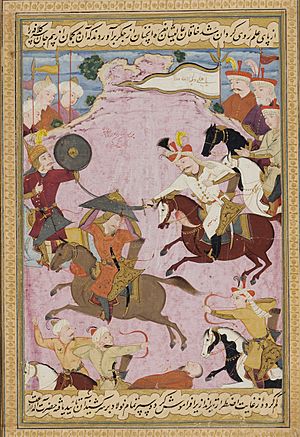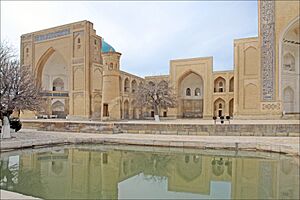Khanate of Bukhara facts for kids
Quick facts for kids
Khanate of Bukhara
|
|||||||||||||||
|---|---|---|---|---|---|---|---|---|---|---|---|---|---|---|---|
| 1501–1785 | |||||||||||||||
|
War flag
|
|||||||||||||||
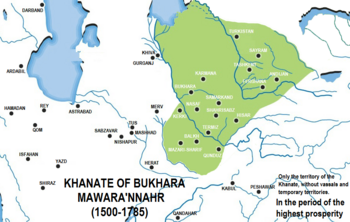
The Khanate of Bukhara (green), c. 1600.
|
|||||||||||||||
| Capital |
39°46′N 64°26′E / 39.767°N 64.433°E |
||||||||||||||
| Common languages |
|
||||||||||||||
| Religion | Islam (Sunni, Naqshbandi Sufism) | ||||||||||||||
| Demonym(s) | Bukharan | ||||||||||||||
| Government | Khanate | ||||||||||||||
| Khan | |||||||||||||||
|
• 1501–1510
|
Muhammad Shibani | ||||||||||||||
|
• 1583–1598
|
Abdullah Khan | ||||||||||||||
|
• 1599–1605
|
Baqi Muhammad Khan | ||||||||||||||
| Ataliq | |||||||||||||||
| Historical era | Early modern period | ||||||||||||||
|
• Muhammad Shibani conquers Bukhara from Timurid Empire
|
1501 | ||||||||||||||
|
• Establishment of Janid dynasty
|
1599 | ||||||||||||||
|
• Khanate is conquered by Nader Shah after Mohammad Hakim surrenders
|
1745 | ||||||||||||||
|
• Manghit dynasty takes control after Nader Shah dies and his empire breaks up
|
1747 | ||||||||||||||
|
• Establishment of Emirate of Bukhara
|
1785 | ||||||||||||||
| Population | |||||||||||||||
|
• 1902
|
2,000,000 est. | ||||||||||||||
|
|||||||||||||||
The Khanate of Bukhara was an Uzbek state in Central Asia. It existed from 1501 to 1785. A "khanate" is a type of kingdom ruled by a "Khan." This state was founded by the Abu'l-Khayrid dynasty. From 1533 to 1540, Bukhara became its capital. The Khanate grew very powerful under Abdullah Khan II (who ruled from 1557 to 1598).
Later, in the 17th and 18th centuries, the Janid dynasty ruled the Khanate. They were the last rulers of Bukhara who were related to Genghis Khan. In 1740, a powerful ruler from Iran, Nader Shah, conquered the Khanate. After Nader Shah died in 1747, the Khanate was controlled by a new group. These new leaders were not related to Genghis Khan. In 1785, their leader, Shah Murad, officially started a new ruling family called the Manghit dynasty. The Khanate then became known as the Emirate of Bukhara. Since the Manghits were not related to Genghis Khan, they used the Islamic title of Emir instead of Khan.
Contents
Early Rulers: The Abu'l-Khayrid Dynasty
How Muhammad Shibani Rose to Power
The first family to rule the Khanate was the Abu'l-Khayrid dynasty. They ruled from 1501 to 1598. This family was part of the Shibanids. They believed they were descendants of Genghis Khan through his son Jochi. The ancestor of this ruling family, Abu'l Khayr Khan, built a large empire. By the time he died in 1469, his empire stretched from Siberia to the Syr Darya river. He controlled important cities like Sighnaq and Yassi.
However, the Uzbek tribes were mostly nomads, meaning they moved around a lot. Abu'l Khayr Khan was not very interested in conquering settled lands. After he died, his empire broke into smaller parts. One of these parts was led by Muhammad Shibani, who was Abu'l Khayr's grandson. Muhammad Shibani was smart and a great military leader. He wanted to conquer the settled lands of Central Asia for himself.
In the 1490s, Muhammad Shibani quickly took over many cities in Central Asia. He conquered Samarqand, Bukhara, Tashkent, and Andijan between 1500 and 1503. One of his biggest rivals was Zahir ud-Din Muhammad Babur. Babur was a prince from the Timurid Empire. He tried to take Samarqand from Muhammad Shibani several times. A key battle between them was the Battle of Sar-e-Pul in 1501, where Babur was defeated.
In 1505, Muhammad Shibani captured Urgench after a long siege. This added Khwarazm to his growing empire. The ruler of Herat, Sultan Husayn Bayqara, tried to fight the Uzbeks but failed. He died in 1506, and his sons tried to form an army. However, Muhammad Shibani captured Balkh in 1506, and the enemy army fell apart. Finally, in 1507, he took Herat and other Timurid lands. By this time, he had taken control of many regions.
However, Shah Isma'il I of the new Safavid Empire wanted to conquer these lands too. He was also angry because Shibani was a strong Sunni Muslim, while he was a Shia Muslim. Shah Isma'il I invaded and killed Muhammad Shibani near the city of Merv in 1510. Khorasan and Khwarazm were then conquered by Iran. Samarqand was briefly taken by Babur in 1512. But the Uzbeks soon got their land back. Khwarazm, however, became permanently independent, forming the Khanate of Khiva.
The Janid Dynasty Takes Over
The Janid dynasty, also known as the Astrakhanids, ruled the Khanate from 1599 to 1747. Their ancestor, Yar Muhammad, and his family had fled from Astrakhan when it fell to the Russians. Yar Muhammad's son, Jani Muhammad, had two sons named Baqi Muhammad and Vali Muhammad Khan. Their mother was the daughter of the last Shaybanid ruler.
In 1599, Baqi Muhammad Khan defeated Pir Muhammad Khan II, who had lost his power. Baqi Muhammad Khan became the true founder of the new Janid dynasty in the Bukhara Khanate. Even though he ruled for a short time, he made important changes. He improved the government, tax system, and military. These changes helped the country grow. He also made coins with his name on them.
During this time, many important works were created. The Uzbek poet Turdy wrote poems that encouraged the unity of the Uzbek people. Another famous Uzbek poet was Mashrab, who wrote in both Chagatai and Persian. His poems are still popular today. In the 17th and early 18th centuries, many historical books were written in Persian. Famous historians included Abdurahman Tole and Muhammad Amin Bukhari.
By the late 17th century, the term "92 Uzbek tribes" was used to describe a part of the population in the Bukhara Khanate. After Ubaydullah Khan was killed in 1711, the state of Bukhara began to break apart. The new Khan, Abu'l-Fayz, had very little power. His authority barely extended beyond the city of Bukhara itself.
The End of the Janids and Rise of the Manghits
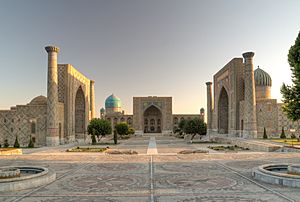
The Ashtarkhanids were eventually replaced by the Uzbek Manghit dynasty. Members of this family ruled Bukhara until 1920.
The Manghit family started gaining political power in the Bukhara Khanate in the early 17th century. Their influence really grew after Khudayar-biy Manghit was appointed to an important position called "atalıq" in 1712. His son, Muhammad Hakim-biy, also held a high position in the Khan's court.
During the invasion by the Persian ruler Nadir Shah in 1740, Muhammad Hakim-biy chose to negotiate for peace. This saved the country from war and made his power even stronger. His third son, Muhammad Rahim, joined Nadir Shah and fought in his campaigns.
From 1740 onwards, the real power in the Bukhara Khanate was held by the Manghit leaders. These included Muhammad Hakim-biy (1740–1743), Muhammad Rakhim (1745–1753), and Daniyal-biy (1758–1785). The Khans of Bukhara became completely dependent on them.
In 1747, after Abulfayz Khan was killed, Muhammad Rahim took full control. Until 1756, the Ashtarkhanid Khans were only rulers in name. Muhammad Rahim himself married the daughter of Abulfayz Khan. Under Muhammad Rahim Bi, the Bukhara Khanate expanded its territory. It grew to include regions like Hissar, Samarqand, and the Zarafshan Valley. Within three years, he also brought other towns under his control. Even though Muhammad Rakhim Khan was not a descendant of Genghis Khan, he was a strong leader. He managed to gain recognition for his power and became Khan.
Rahim Bi had to control the power of local leaders. He attacked the ruler of Nurota, who was then forced to accept Bukhara's rule. In 1753, Rahim Bi attacked Urgut and brought Shahr-i Sabz, Hissar, and Kulab under his control. In 1754, he successfully added Khujand, Tashkent, and Turkestan to the Khanate. In 1762, Bukharan armies conquered the town of Charjuy and brought the Turkmen people under their rule.
Culture and Learning
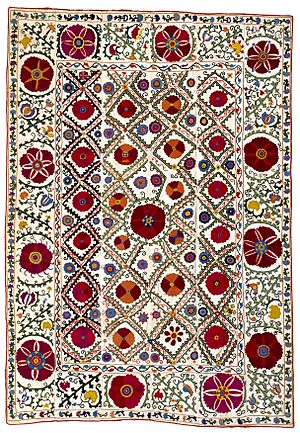
Muhammad Shibani, the first ruler, loved poetry. Collections of his poems written in the Turkic language still exist today. He also wrote poetry in Persian. A collection of his Turkic poems is kept in Istanbul, Turkey. A manuscript of his philosophical and religious work, "Bahr ul-Khudo," written in 1508, is in London.
Muhammad Shibani used the pen name "Shibani" for his poetry. He also wrote a prose work called "Risale-yi maarif-i Shibani" in 1507. This book was written in the Turkic-Chagatai language and was for his son. Ubaydullah Khan was also a very educated person. He could recite the Koran skillfully and wrote comments on it in Turkic. He was also a talented singer and musician. He helped create an important group of writers and scholars in Central Asia. Ubaydullah Khan wrote poetry in Turkic, Persian, and Arabic.
During the early 16th century, more historical works were written in Turkish. Muhammad Shibani Khan's rule inspired a Turkish historical work called the "Shibani-nama." The Khan also supported the translation of several Persian works into the Chaghatai language.
In the Abu'l-Khayrid era, there was a famous scholarly woman named Agha-i Buzurg, or "Great Lady." She was a Sufi scholar and was also known as "Mastura Khatun." She died around 1522–23.
Abd al-Aziz Khan (who ruled from 1540 to 1550) created a library that was considered "having no equal" in the world. A famous scholar named Sultan Mirak Munshi worked there. A talented calligrapher named Mir Abid Khusaini created beautiful works of art. He was also a brilliant miniature-painter and worked as the librarian for Bukhara's library.
Important Rulers of the Khanate
Janid Dynasty Khans
- Baqi Muhammad Khan (1599–1605)
- Vali Muhammad Khan (1605–1611)
- Imam Quli Khan (1611–1642)
- Nadr Muhammad Khan (1642–1645)
- Abd al-Aziz Khan (1645–1680)
- Subhan Quli Khan (1680–1702)
- Ubaidullah Khan (1702 – March 18, 1711)
- Abu'l-Fayz Khan (1711–1747)
- Muhammad Abd al-Mumin (1747–1748)
- Muhammad Ubaidullah II (1748–1753, nominal ruler)
Manghit Dynasty Rulers
- Muhammad Rahim (took power, was atalik 1753–1756, then khan 1756–1758)
- Shir Ghazi (1758–?)
- Abu'l-Ghazi Khan (1758–1785)
See also
 In Spanish: Kanato de Bujará para niños
In Spanish: Kanato de Bujará para niños
- Russian conquest of Central Asia
- List of Sunni Muslim dynasties



